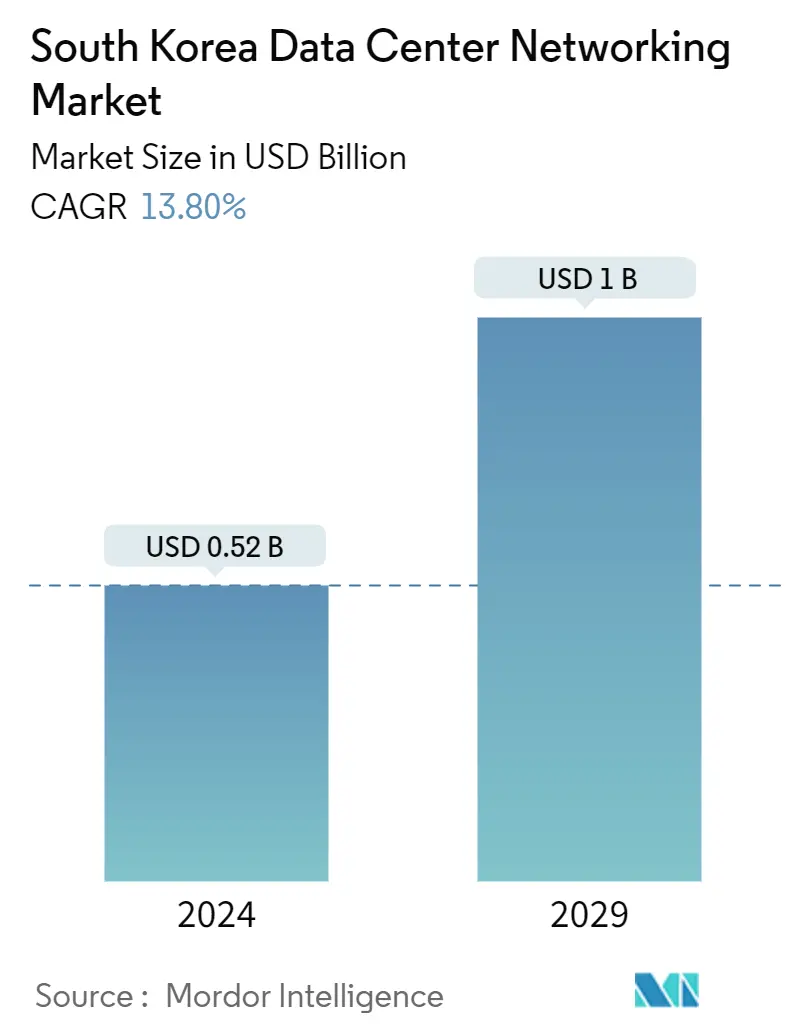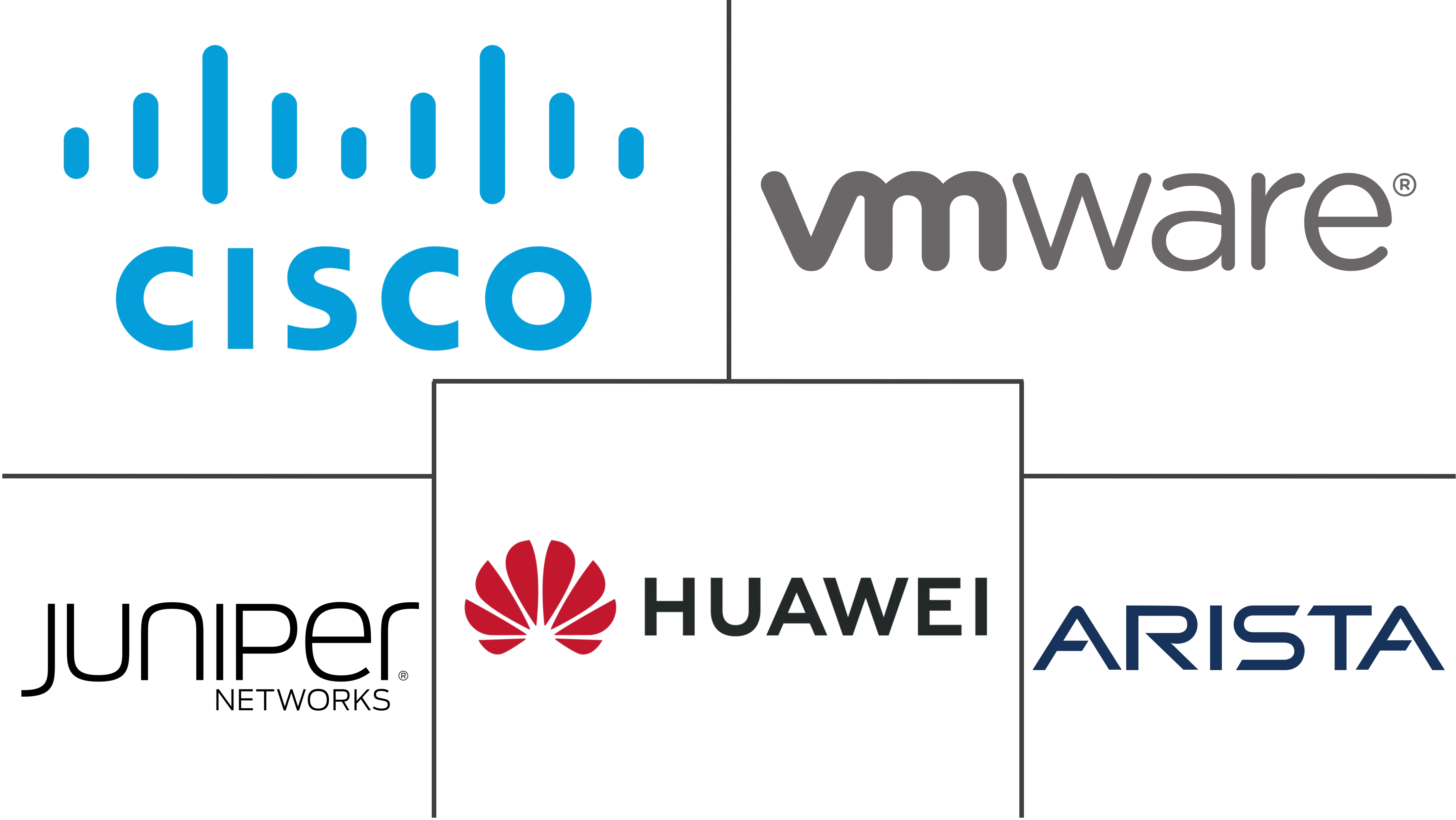Market Size of South Korea Data Center Networking Industry

| Study Period | 2018 - 2029 |
| Base Year For Estimation | 2023 |
| Market Size (2024) | USD 0.52 Billion |
| Market Size (2029) | USD 1 Billion |
| CAGR (2024 - 2029) | 13.80 % |
| Market Concentration | High |
Major Players
*Disclaimer: Major Players sorted in no particular order |
South Korea Data Center Networking Market Analysis
The South Korea Data Center Networking Market size is estimated at USD 0.52 billion in 2024, and is expected to reach USD 1 billion by 2029, growing at a CAGR of 13.80% during the forecast period (2024-2029).
- As one of the key objectives, South Korea's K-Network 2030 strategy aims to strengthen and upgrade the country's network infrastructure while developing energy-efficient and fail-proof systems. South Korea has set the goal of doubling its optical communication speed by 2026 and quadrupling it by 2030.
- Meanwhile, it will also boost the country's submarine cable transmission capacity. South Korea aims to raise the packet optical transport network (POTN) speed from 100Gbps at present to 200Gbps by 2026 and 400Gbps by 2030 while largely boosting the transmission capacity. Such a factor caters to positive market growth.
- Under Construction IT Load Capacity: The upcoming IT load capacity of the South Korean data center market is expected to reach 2K MW by 2029.
- Under Construction Raised Floor Space: The country's construction of raised floor area is expected to increase to 5.7 million sq. ft by 2029.
- Planned Racks: The country's total number of racks to be installed is expected to reach 285,816 units by 2029. Greater Seoul is expected to house the maximum number of racks in the coming years.
- Planned Submarine Cables: There are close to 11 submarine cable systems connecting South Korea, and many are under construction. One such submarine cable that is estimated to start service in 2025 is Bridge One, which stretches over 330 Kilometers with landing points from Pohang, South Korea.
South Korea Data Center Networking Industry Segmentation
Data center networking refers to the set of technologies, protocols, and hardware used to connect physical and network-based devices and manage the network infrastructure, storage, and processing of applications and data. Data center networking is very critical for 100% uptime of data centers. In the current web-connected world, business workloads are executed on single computers, hence leading to the need for data center networking. Networks provide servers, clients, applications, and middleware with a standard plan to stage the execution of workloads and also to manage access to the data produced.
The South Korean data center networking market is segmented by product (ethernet switches, routers, storage area network (SAN), application delivery controllers (ADC), and other networking equipment), by services (installation & integration, training & consulting, and support & maintenance), and by end-user (IT & telecommunication, BFSI, government, media & entertainment, and other end users).
The market sizes and forecasts are provided in terms of value (USD) for all the above segments.
| By Component | |||||||
| |||||||
|
| End-User | |
| IT & Telecommunication | |
| BFSI | |
| Government | |
| Media & Entertainment | |
| Other End-Users |
South Korea Data Center Networking Market Size Summary
The South Korean Data Center Networking market is poised for substantial growth, driven by strategic initiatives like the K-Network 2030 plan, which aims to enhance the country's network infrastructure and increase optical communication speeds. This growth is further supported by the expansion of submarine cable systems and advancements in packet optical transport networks. The market is also witnessing a surge in IT load capacity, raised floor space, and the number of racks, particularly in Greater Seoul. The financial services sector, a significant contributor to this market, is embracing digital transformation with the rise of digital banks and increased adoption of cloud services, spurred by regulatory changes that allow for broader use of cloud technology. This shift is expected to boost demand for data center networking solutions, especially as the sector prepares for further digitization and cost optimization.
The market landscape is characterized by intense competition and consolidation, with major players like Cisco Systems Inc., Arista Networks Inc., and others employing strategies such as mergers, acquisitions, and partnerships to strengthen their market position. Innovations in application delivery controllers and cloud-based solutions are enhancing security and accessibility, addressing the rising threat of cyber attacks. The integration of networking solutions with major cloud providers like AWS, Microsoft Azure, and Google Cloud Platform is also a key trend, offering flexibility and scalability to meet evolving business needs. As these technologies continue to evolve, the South Korean Data Center Networking market is expected to expand significantly, driven by both technological advancements and increasing demand from various sectors.
South Korea Data Center Networking Market Market Size - Table of Contents
-
1. Market Dynamics
-
1.1 Market Overview
-
1.2 Market Drivers
-
1.2.1 Rising Adoption of Mega Data Centers and Cloud Computing
-
1.2.2 Increasing Demand to Reduce Operational Costs
-
-
1.3 Market Restraints
-
1.3.1 High Cost of Installation and Maintenance
-
-
1.4 Value Chain / Supply Chain Analysis
-
1.5 Industry Attractiveness - Porter's Five Forces Analysis
-
1.5.1 Threat of New Entrants
-
1.5.2 Bargaining Power of Buyers/Consumers
-
1.5.3 Bargaining Power of Suppliers
-
1.5.4 Threat of Substitute Products
-
1.5.5 Intensity of Competitive Rivalry
-
-
1.6 Assessment of COVID-19 Impact
-
-
2. MARKET SEGMENTATION
-
2.1 By Component
-
2.1.1 By Product
-
2.1.1.1 Ethernet Switches
-
2.1.1.2 Routers
-
2.1.1.3 Storage Area Network (SAN)
-
2.1.1.4 Application Delivery Controller (ADC)
-
2.1.1.5 Other Networking Equipment
-
-
2.1.2 By Services
-
2.1.2.1 Installation & Integration
-
2.1.2.2 Training & Consulting
-
2.1.2.3 Support & Maintenance
-
-
-
2.2 End-User
-
2.2.1 IT & Telecommunication
-
2.2.2 BFSI
-
2.2.3 Government
-
2.2.4 Media & Entertainment
-
2.2.5 Other End-Users
-
-
South Korea Data Center Networking Market Market Size FAQs
How big is the South Korea Data Center Networking Market?
The South Korea Data Center Networking Market size is expected to reach USD 0.52 billion in 2024 and grow at a CAGR of 13.80% to reach USD 1 billion by 2029.
What is the current South Korea Data Center Networking Market size?
In 2024, the South Korea Data Center Networking Market size is expected to reach USD 0.52 billion.

